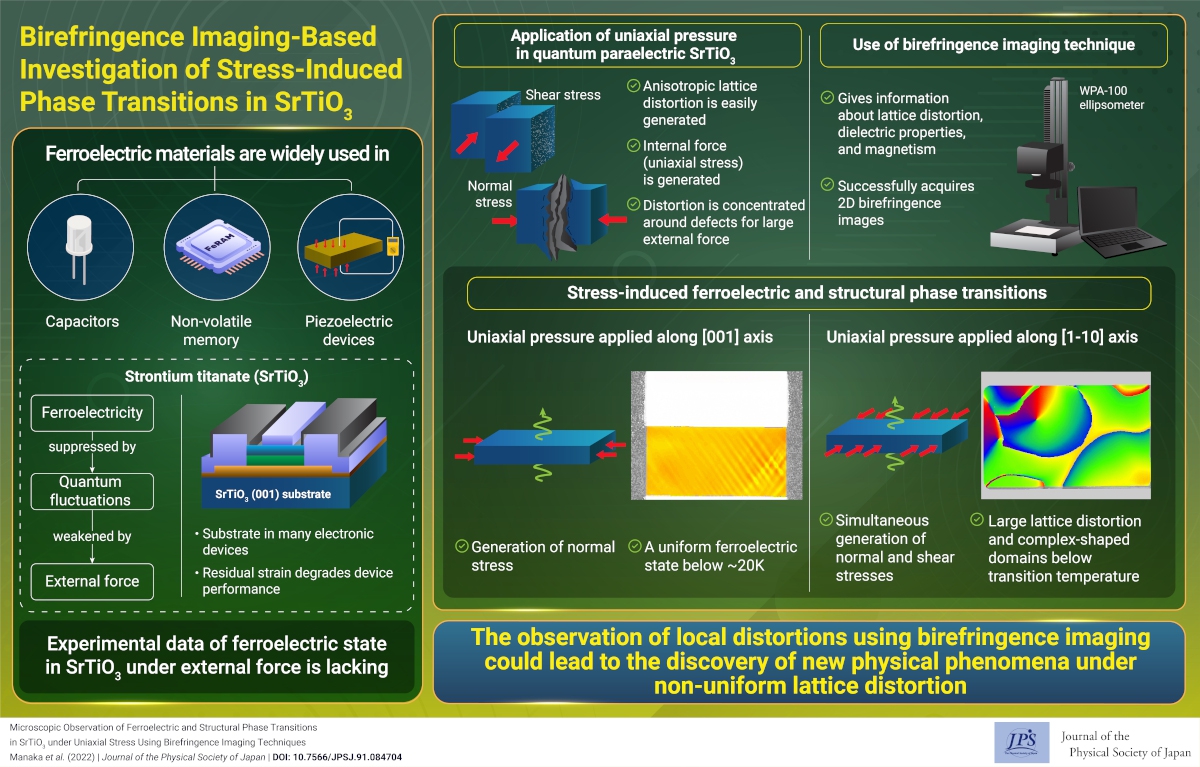Birefringence Imaging-Based Investigation of Stress-Induced Phase Transitions in SrTiO3
© The Physical Society of Japan
This article is on
Microscopic Observation of Ferroelectric and Structural Phase Transitions in SrTiO3 under Uniaxial Stress Using Birefringence Imaging Techniques
(JPSJ Editors' Choice)
J. Phys. Soc. Jpn. 91, 084704 (2022).
The spatial distributions of ferroelectric and structural phase transitions in quantum paraelectric SrTiO3 under uniaxial stress were microscopically observed using birefringence imaging techniques.

Ferroelectric materials are widely used as capacitors that can store a large electric charge as well as non-volatile memory (FeRAM), piezoelectric devices, and actuators. In strontium titanate (SrTiO3), ferroelectricity is suppressed by quantum fluctuations, resulting in quantum paraelectricity below the structural phase transition temperature (Tc = 105 K). Furthermore, it has been demonstrated that applying an external force weakens quantum fluctuation, resulting in the appearance of the ferroelectric state. There are two methods for applying an external force (pressure) to crystals. In the case of hydrostatic pressure, the external force causes isotropic compression in the crystals and almost uniform lattice distortion. However, in the case of uniaxial pressure, anisotropic lattice distortion that cannot be achieved by hydrostatic pressure is easily generated when an external force is applied in a specific direction. By applying uniaxial pressure, an internal force is generated in the crystals based on the laws of action and reaction. This internal force is generally called “(uniaxial) stress”. When the external force is large, lattice distortion is concentrated around the defects owing to the increase in dislocations. To quantitatively evaluate such non-uniform lattice distortions, a new experimental technique is expected to be developed.
Birefringence is well known to be responsible for the phenomenon of double refraction, which occurs when a ray of light passes through calcite. The difference in refractive indices causes retardation, which provides information about lattice distortion, dielectric properties, and magnetism. Therefore, birefringence measurements have been widely used for many years. However, evaluating the non-uniform state has been difficult because conventional measurements using a laser beam can observe it at only one point. To solve this issue, the authors were able to obtain two-dimensional birefringence images under an external force.
In this study, when an external force was applied along [001] in quantum paraelectric SrTiO3, the ferroelectric state induced by normal stress appeared almost uniformly below 20 K. However, when an external force was applied along [1-10], a large lattice distortion that was impossible to attain was generated, and complex-shaped domains emerged below Tc owing to the simultaneous generation of the normal and shear stresses. Although the temperature dependence of retardance in each domain was investigated, the ferroelectric state could not be observed. This could be because, under our experimental conditions, the degree of lattice distortion never reached a critical value without breaking the crystal. If the birefringence can be efficiently mined from large amounts of image data by using statistics and AI, there is a possibility that new physical phenomena will be discovered under non-uniform lattice distortion.
(Written by H. Manaka on behalf of all authors).
Microscopic Observation of Ferroelectric and Structural Phase Transitions in SrTiO3 under Uniaxial Stress Using Birefringence Imaging Techniques
(JPSJ Editors' Choice)
J. Phys. Soc. Jpn. 91, 084704 (2022).
Share this topic
Fields
Related Articles
-
d2 Trimer and d3 Tetramer in a Pyrochlore Lattice
Dielectric, optical, and other properties in condensed matter
Electron states in condensed matter
2024-7-11
Based on the charge disproportionation of V3+ and V2+, the V3+(d2) trimers and V2+(d3) tetramers in the vanadium pyrochlore lattice of AlV2O4 are described by the orbitally-induced Peierls mechanism.
-
Structural Rotation and Falsely Chiral Antiferromagnetism: A New Combination Generating Ferrotoroidic State
Magnetic properties in condensed matter
Dielectric, optical, and other properties in condensed matter
2024-7-4
The ferrotoroidic state, an exotic state of matter with broken space inversion and time-reversal symmetries, was achieved by combining structural rotation and falsely chiral antiferromagnetism in PbMn2Ni6Te3O18.
-
Current Melt Frozen Electrons
Dielectric, optical, and other properties in condensed matter
Magnetic properties in condensed matter
2024-1-15
The origin of the current-induced insulator-to-metal transition of samarium monosulfide was explained by the 4f−5d hybridization observed using optical reflectivity and photoelectron spectroscopies.
-
One-Way Optical Waveguide Realized by Edge Modes of Topological Photonic Crystals
Electromagnetism, optics, acoustics, heat transfer, and classical and fluid mechanics
Dielectric, optical, and other properties in condensed matter
2023-12-12
A one-way optical waveguide was realized on the boundary between two types of photonic crystals with different topological properties, which were demonstrated by high-resolution infrared reflection measurements.
-
Dzyaloshinskii–Moriya Interactions in Magnetism, Electricity, and Electronics
Magnetic properties in condensed matter
Electron states in condensed matter
Dielectric, optical, and other properties in condensed matter
2023-10-12
A collection of papers in the Journal of the Physical Society of Japan advances our understanding of Dzyaloshinskii–Moriya interaction and paves the way for developing next generation computing and electronic systems.
